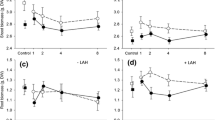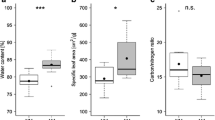Abstract
Most terrestrial plants live in symbiosis with arbuscular mycorrhizal (AM) fungi. Studies on the direct interaction between plants and mycorrhizal fungi are numerous whereas studies on the indirect interaction between such fungi and herbivores feeding on aboveground plant parts are scarce. We studied the impact of AM symbiosis on host plant choice and life history of an acarine surface piercing-sucking herbivore, the polyphagous two-spotted spider mite Tetranychus urticae. Experiments were performed on detached leaflets taken from common bean plants (Phaseolus vulgaris) colonized or not colonized by the AM fungus Glomus mosseae. T. urticae females were subjected to choice tests between leaves from mycorrhizal and non-mycorrhizal plants. Juvenile survival and development, adult female survival, oviposition rate and offspring sex ratio were measured in order to estimate the population growth parameters of T. urticae on either substrate. Moreover, we analyzed the macro- and micronutrient concentration of the aboveground plant parts. Adult T. urticae females preferentially resided and oviposited on mycorrhizal versus non-mycorrhizal leaflets. AM symbiosis significantly decreased embryonic development time and increased the overall oviposition rate as well as the proportion of female offspring produced during peak oviposition. Altogether, the improved life history parameters resulted in significant changes in net reproductive rate, intrinsic rate of increase, doubling time and finite rate of increase. Aboveground parts of colonized plants showed higher concentrations of P and K whereas Mn and Zn were both found at lower levels. This is the first study documenting the effect of AM symbiosis on the population growth rates of a herbivore, tracking the changes in life history characteristics throughout the life cycle. We discuss the AM-plant-herbivore interaction in relation to plant quality, herbivore feeding type and site and the evolutionary implications in a multi-trophic context.


Similar content being viewed by others
References
Allen MF (1996) The ecology of arbuscular mycorrhizas: a look back into the 20th century and a peek into the 21st. Mycol Res 100:769–782
Awmack CS, Leather SR (2002) Host plant quality and fecundity in herbivorous insects. Annu Rev Entomol 47:817–844
Bennett AE, Alers-Garcia J, Bever JD (2006) Three-way interactions among mutualistic mycorrhizal fungi, plants, and plant enemies: hypotheses and synthesis. Am Nat 167:141–152
Bennett AE, Bever JD (2007) Mycorrhizal species differentially alter plant growth and response to herbivory. Ecology 88:210–218
Benton TG, Plaistow SJ, Beckerman AP, Lapsley CT, Littlejohns S (2005) Changes in maternal investment in eggs can affect population dynamics. Proc R Soc B Biol Sci 272:1351–1356
Bernardo J (1996) Maternal effects in animal ecology. Am Zool 36:83–105
Bolland HR, Gutierrez J, Flechtmann CHW (1998) World catalogue of the spider mite family (Acari, Tetranychidae). Brill, Leiden
Borowicz VA (1997) A fungal root symbiont modifies plant resistance to an insect herbivore. Oecologia 112:534–542
Bowman RA (1989) A sequential extraction procedure with concentrated sulfuric acid and dilute base for soil organic phosphorus. Soil Sci Soc Am J 53:362–366
Cannon WN, Terriere LC (1966) Egg production of the two-spotted spider mite on bean plants supplied nutrient solutions containing various concentrations of iron, manganese, zinc and cobalt. J Econ Entomol 59:89–90
Cole LC (1954) The population consequences of life history phenomena. Q Rev Biol 29:103–137
Gange AC (2007) Insect-mycorrhizal interactions: patterns, processes, and consequences. In: Ohgushi T, Craig P, Price PW (eds) Ecological communities: plant mediation in indirect interaction webs. Cambridge University Press, Cambridge, pp 134–144
Gange AC, Bower E, Brown VK (2002) Differential effects of insect herbivory on arbuscular mycorrhizal colonization. Oecologia 131:103–112
Gange AC, Brown VK, Aplin DM (2003) Multitrophic links between arbuscular mycorrhizal fungi and insect parasitoids. Ecol Lett 6:1051–1055
Gange AC, Nice HE (1997) Performance of the thistle gall fly, Urophora cardui, in relation to host plant nitrogen and mycorrhizal colonization. New Phytol 137:335–343
Gange AC, West HM (1994) Interactions between arbuscular mycorrhizal fungi and foliar-feeding insects in Plantago lanceolata L. New Phytol 128:79–87
Gehring CA, Whitham TG (2002) Mycorrhizae-herbivore interactions: population and community consequences. In: van der Heijden MGA, Sanders IR (eds) Mycorrhizal ecology. Springer, Berlin, pp 295–320
Goverde M, van der Heijden MGA, Wiemken A, Sanders IR, Erhardt A (2000) Arbuscular mycorrhizal fungi influence life history traits of a lepidopteran herbivore. Oecologia 125:362–369
Guerrieri E, Lingua G, Digilio MC, Massa N, Berta G (2004) Do interactions between plant roots and the rhizosphere affect parasitoid behaviour? Ecol Entomol 29:753–756
Hart M, Klironomos JN (2002) Diversity of arbuscular mycorrhizal fungi and ecosystem functioning. In: van der Hejden MGA, Sanders IR (eds) Mycorrhizal ecology. Springer, Berlin, pp 225–239
Helle W, Sabelis MW (eds) (1985) Spider mites: their biology, natural enemies and control. Elsevier, Amsterdam
Kagata H, Ohgushi T (2006) Bottom-up trophic cascades and material transfer in terrestrial food webs. Ecol Res 21:26–34
Khaosaad T, Krenn L, Medjakovic S, Ranner A, Lössl A, Nell M, Jungbauer A, Vierheilig H (2008) Effect of mycorrhization on the isoflavone content and the phytoestrogen activity of red clover. J Plant Physiol 165:1161–1167
Koide RT, Mosse B (2004) A history of research on arbuscular mycorrhiza. Mycorrhiza 14:145–163
Koschier EH, Khaosaad T, Vierheilig H (2007) Root colonization by the arbuscular mycorrhizal fungus Glomus mosseae and enhanced phosphorous levels in cucumber do not affect host acceptance and development of Frankliniella occidentalis. J Plant Interact 2:11–15
Kula AAR, Hartnett DC, Wilson GWT (2005) Effects of mycorrhizal symbiosis on tallgrass prairie plant-herbivore interactions. Ecol Lett 8:61–69
Maia ADN, Luiz AJB, Campanhola C (2000) Statistical inference on associated fertility life table parameters using jackknife technique: computational aspects. J Econ Entomol 93:511–518
Munkvold L, Kjoller R, Vestberg M, Rosendahl S, Jakobsen I (2004) High functional diversity within species of arbuscular mycorrhizal fungi. New Phytol 164:357–364
Murphy J, Riley JP (1962) A modified single solution method for determination of phosphate in natural waters. Anal Chim Acta 26:31–32
Newman EI (1966) A method of estimating total length of root in a sample. J Appl Ecol 3:139–140
Ponce MA, Scervino JM, Erra-Balsells R, Ocampo JA, Godeas AM (2004) Flavonoids from shoots and roots of Trifolium repens (white clover) grown in presence or absence of the arbuscular mycorrhizal fungus Glomus intraradices. Phytochemistry 65:1925–1930
Potter DA, Wrensch DL, Johnston DE (1976) Aggression and mating success in male spider mites. Science 193:160–161
Rabin LB, Pacovsky RS (1985) Reduced larva growth of two Lepidoptera (Noctuidae) on excised leaves of soybean infected with a mycorrhizal fungus. J Econ Entomol 78:1358–1363
Read DJ (1998) Mycorrhiza—the state of the art. In: Varma A, Hock B (eds) Mycorrhiza. Springer, Berlin, pp 3–34
Rodriguez JG (1954) Radiophosphorus in metabolism studies in the 2-spotted spider mite. J Econ Entomol 47:514–517
Rodriguez JG, Rodriguez LD (1987) Nutritional ecology of phytophagous mites. In: Slansky F, Rodriguez J (eds) Nutritional ecology of insects, mites and spiders. Wiley, New York, pp 177–205
Roy M, Brodeur J, Cloutier C (2003) Temperature and sex allocation in a spider mite. Oecologia 135:322–326
Sabelis MW (1985) Reproductive strategies. In: Helle W, Sabelis MW (eds) Spider mites: their biology, natural enemies and control, vol 1A. Elsevier, Amsterdam, pp 265–276
Sabelis MW, Van Baalen M, Bakker FM, Bruin J, Drukker B, Egas M, Janssen ARM, Lesna IK, Pels B, Van Rijn PCJ, Scutareanu P (1999) The evolution of direct and indirect plant defence against herbivorous arthropods. In: Olff H, Brown VK, Drent RH (eds) Herbivores: between plants and predators. Blackwell, Oxford, pp 109–166
Schoonhoven LM, Jeremy T, van Loon JJA (1998) Insect-plant biology: from physiology to evolution. Chapman & Hall, London
Smith SE, Read DJ (1997) Mycorrhizal symbiosis, 2nd edn. Academic Press, San Diego
Strauss SY, Agrawal AA (1999) The ecology and evolution of plant tolerance to herbivory. Trends Ecol Evol 14:179–185
Suski ZW, Badowska T (1975) Effect of host plant nutrition on the population growth of the two spotted spider mite, Tetranychus urticae Koch (Acarina, Tetranychidae). Ekol Polska 23:185–209
Thomas RL, Sheard RW, Moyer JR (1967) Comparison of conventional and automated procedures for nitrogen, phosphorus and potassium analysis of plant material using a single digestion. Agron J 59:240
Tomczyk A, Kropczynska D (1985) Effects on the host plant. In: Helle W, Sabelis MW (eds) Spider mites: their biology, natural enemies and control, vol 1A. Elsevier, Amsterdam, pp 317–327
Vanas V, Enigl M, Walzer A, Schausberger P (2006) The predatory mite Phytoseiulus persimilis adjusts patch-leaving to own and progeny prey needs. Exp Appl Acarol 39:1–11
van der Meijden E (1996) Plant defence, an evolutionary dilemma: contrasting effects of (specialist and generalist) herbivores and natural enemies. Entomol Exp Appl 80:307–310
Vicari M, Hatcher PE, Ayres PG (2002) Combined effect of foliar and mycorrhizal endophytes on an insect herbivore. Ecology 83:2452–2464
Vierheilig H, Coughlan AP, Wyss U, Piche Y (1998) Ink and vinegar, a simple staining technique for arbuscular-mycorrhizal fungi. Appl Environ Microbiol 64:5004–5007
Walzer A, Paulus HF, Schausberger P (2006) Oviposition behavior of interacting predatory mites: response to the presence of con- and heterospecific eggs. J Insect Behav 19:305–320
Wamberg C, Christensen S, Jakobsen I (2003) Interaction between foliar-feeding insects, mycorrhizal fungi, and rhizosphere Protozoa on pea plants. Pedobiologia 47:281–287
Wermelinger B, Oertli JJ, Baumgartner J (1991) Environmental factors affecting the life-tables of Tetranychus urticae (Acari, Tetranychidae). III. Host-plant nutrition. Exp Appl Acarol 12:259–274
Wooley SC, Paine TD (2007) Can intra-specific genetic variation in arbuscular mycorrhizal fungi (Glomus etunicatum) affect a mesophyll-feeding herbivore (Tupiocoris notatus Distant)? Ecol Entomol 32:428–434
Wrensch DL (1985) Reproductive parameters. In: Helle W, Sabelis MW (eds) Spider mites: their biology, natural enemies and control, vol 1A. Elsevier, Amsterdam, pp 165–170
Wrensch DL, Young SSY (1983) Relationship between primary and tertiary sex ratio in the 2-spotted spider-mite (Acarina, Tetranychidae). Ann Entomol Soc Am 76:786–789
Yano S, Wakabayashi M, Takabayashi J, Takafuji A (1998) Factors determining the host plant range of the phytophagous mite, Tetranychus urticae (Acari: Tetranychidae): a method for quantifying host plant acceptance. Exp Appl Acarol 22:595–601
Acknowledgements
We thank Andreas Walzer and Laté M. Lawson-Balagbo, both at the Institute of Plant Protection, BOKU, Vienna, for helpful comments on the manuscript and Andreas Lössl, Institute of Agronomy and Plant Breeding, BOKU, Vienna, for nutrient analysis. Daniela Hoffmann is a recipient of a DOC-FForte fellowship of the Austrian Academy of Sciences. All experiments performed comply with the current laws of Austria.
Author information
Authors and Affiliations
Corresponding author
Additional information
Communicated by Roland Brandl.
An erratum to this article is available at http://dx.doi.org/10.1007/s00442-010-1852-5.
Rights and permissions
About this article
Cite this article
Hoffmann, D., Vierheilig, H., Riegler, P. et al. Arbuscular mycorrhizal symbiosis increases host plant acceptance and population growth rates of the two-spotted spider mite Tetranychus urticae . Oecologia 158, 663–671 (2009). https://doi.org/10.1007/s00442-008-1179-7
Received:
Accepted:
Published:
Issue Date:
DOI: https://doi.org/10.1007/s00442-008-1179-7




